For those who like to talk smack about semi-chisel chain, calling it slow and inefficient, I offer a couple pictures of the sort of work that semi-chisel chain is ideally suited for.
Last weekend we did some work at the nature preserve, practicing woody debris management. We broke up some larger log jams, removed trash, and restored river flow. Larger deadfall is cabled to the bank, often only at the upstream end of the tree to serve as a floating sweep, and to mitigate the force of the river against the silty banks that erode easily. A decade ago we would completely remove the jams, but this new method seems to work better for preserving streambanks and shoreline creating habitat for aquatic life.
The chain used was a fresh loop of GB semi-chisel. I got two tanks out of it before it started to show a reduction in chip size. Not bad, considering what we were cutting.
Volunteers begin taking a smaller log jam apart. Small woody material is thrown into the eroded hole in the bank that the jam caused, and trash is removed and hauled out. The re-filled hole will collect sediment in the next couple storms and the bank will be substantially stabilized.

Wet + Sandy + Dirty = not a place for square chisel chain.
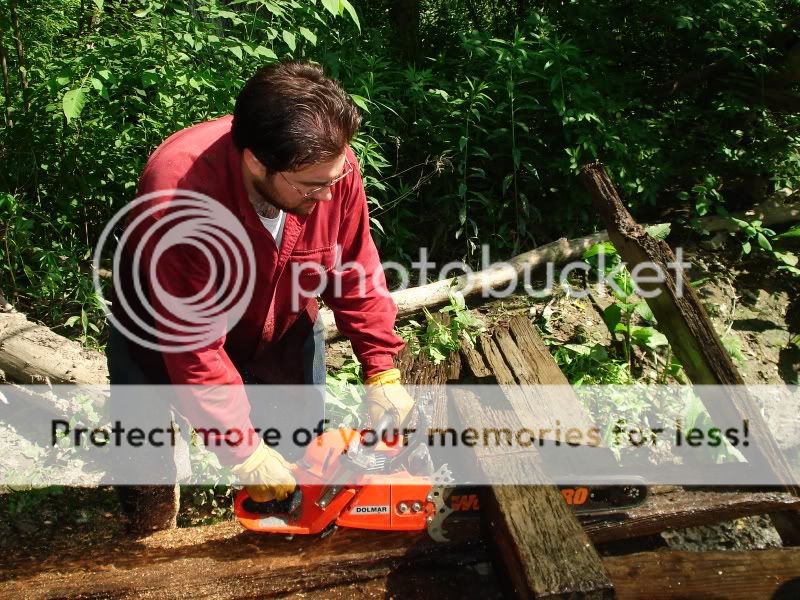
More waterlogged lumber, complete with nails. This stuff came from a couple bridges upstream. Idiotic kids tore all the wooden deck boards off and threw them into the river, where they jammed the river up and caused substantial erosion on both sides of the bank. We also removed and cut up dozens of 4x8 sheets of plywood.
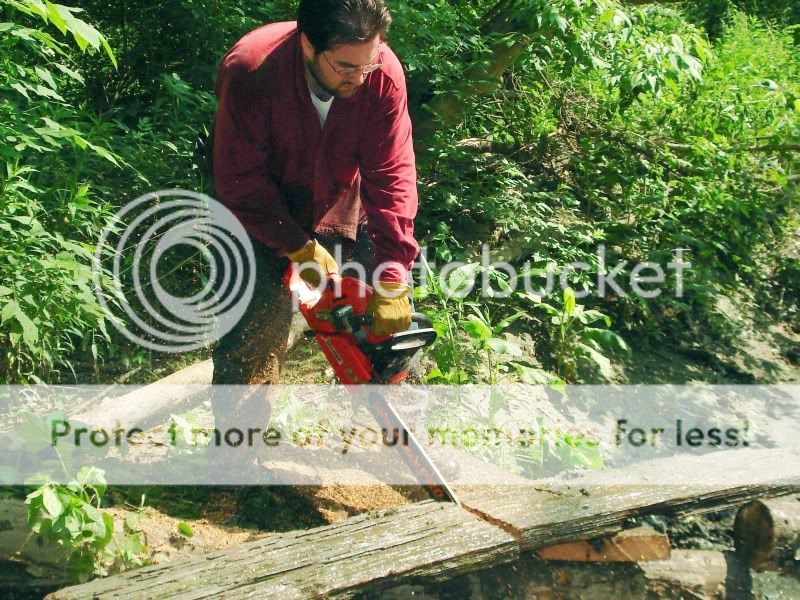
A staged shot. Notice the waterline on my shirt - I'm not sure that there is a good PPE product to protect oneself when cutting in deep water. In past years on larger jams we worked in water up to chest-deep. In this picture I still have a handful of plastic bags stuck in my back pocket, even after the volunteers used a good two or three dozen bags to haul out trash from a couple of the logjams.
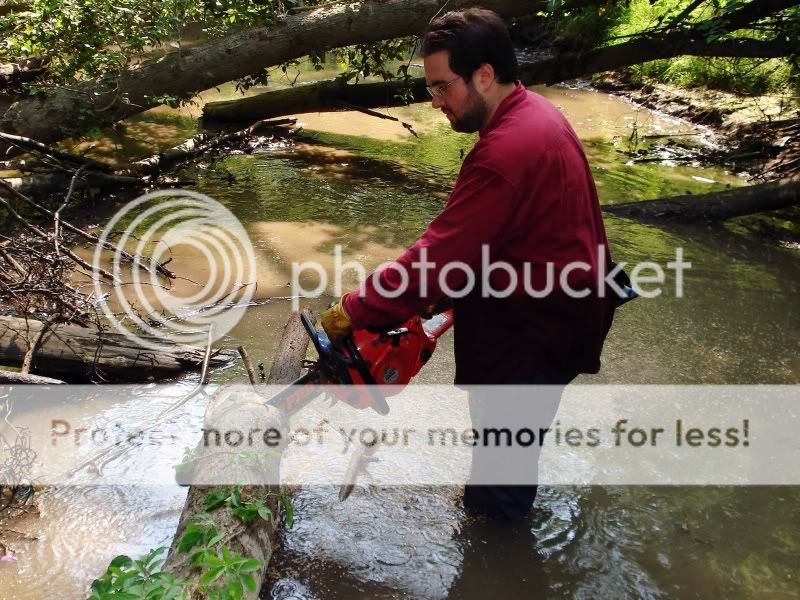
Floating lumber upstream to the removal site. High School student volunteers then carried the material back to the staging area, 3/8 of a mile away.
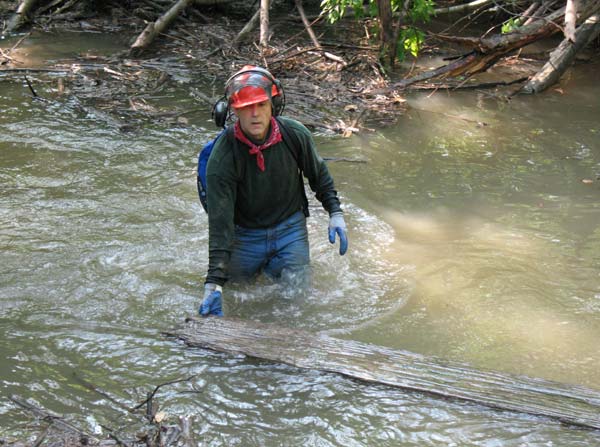
Yes, his tricky moves landed him in the river. And no, shorts are NOT actually proper clothing for this sort of work.
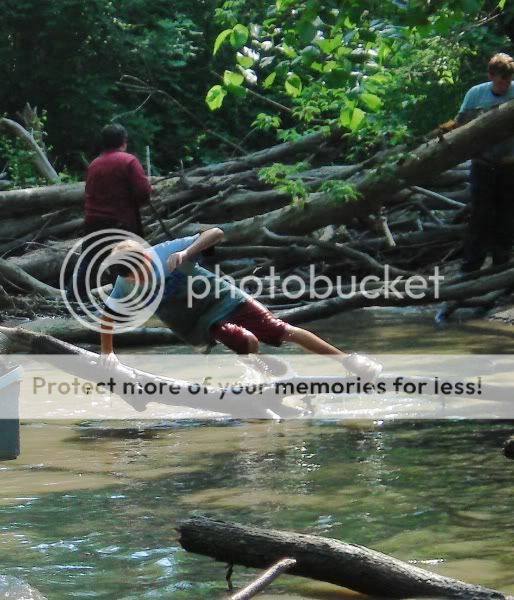
Climbing out of a jam, post-opening. When we started on this jam the debris was mounded up to within six inches of the large logs and the upstream water level was a foot and a half higher than the downstream (which it should not be here). You can see that there is now a proper opening in the jam, allowing water to flow through. Subsequent stoms will remove much of the small debris in the center of the jam.

Last weekend we did some work at the nature preserve, practicing woody debris management. We broke up some larger log jams, removed trash, and restored river flow. Larger deadfall is cabled to the bank, often only at the upstream end of the tree to serve as a floating sweep, and to mitigate the force of the river against the silty banks that erode easily. A decade ago we would completely remove the jams, but this new method seems to work better for preserving streambanks and shoreline creating habitat for aquatic life.
The chain used was a fresh loop of GB semi-chisel. I got two tanks out of it before it started to show a reduction in chip size. Not bad, considering what we were cutting.
Volunteers begin taking a smaller log jam apart. Small woody material is thrown into the eroded hole in the bank that the jam caused, and trash is removed and hauled out. The re-filled hole will collect sediment in the next couple storms and the bank will be substantially stabilized.

Wet + Sandy + Dirty = not a place for square chisel chain.

More waterlogged lumber, complete with nails. This stuff came from a couple bridges upstream. Idiotic kids tore all the wooden deck boards off and threw them into the river, where they jammed the river up and caused substantial erosion on both sides of the bank. We also removed and cut up dozens of 4x8 sheets of plywood.

A staged shot. Notice the waterline on my shirt - I'm not sure that there is a good PPE product to protect oneself when cutting in deep water. In past years on larger jams we worked in water up to chest-deep. In this picture I still have a handful of plastic bags stuck in my back pocket, even after the volunteers used a good two or three dozen bags to haul out trash from a couple of the logjams.

Floating lumber upstream to the removal site. High School student volunteers then carried the material back to the staging area, 3/8 of a mile away.

Yes, his tricky moves landed him in the river. And no, shorts are NOT actually proper clothing for this sort of work.

Climbing out of a jam, post-opening. When we started on this jam the debris was mounded up to within six inches of the large logs and the upstream water level was a foot and a half higher than the downstream (which it should not be here). You can see that there is now a proper opening in the jam, allowing water to flow through. Subsequent stoms will remove much of the small debris in the center of the jam.

























































